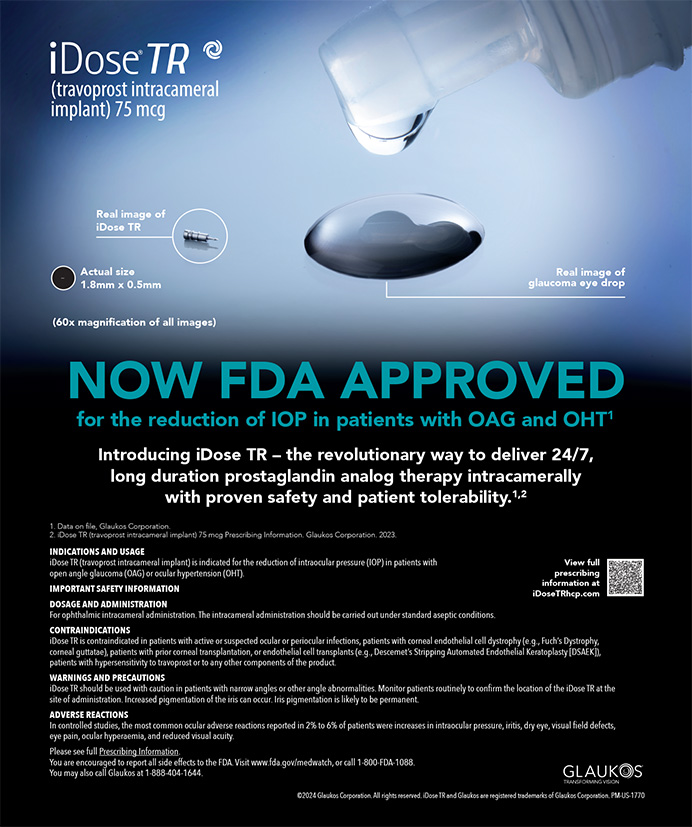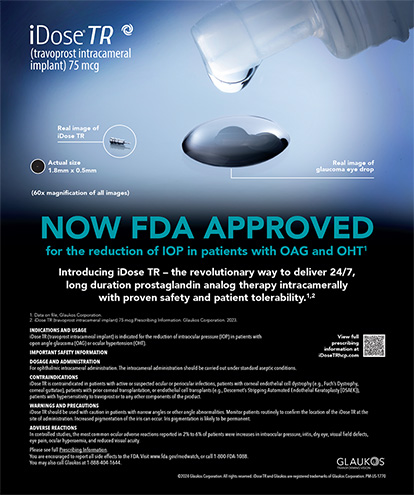I implanted my very first iStent Trabecular Micro-Bypass Stent (Glaukos Corporation) more than 7 years ago as a part of the first-ever FDA premarket approval study of a glaucoma device. It has been only been 14 months, however, since the agency approved the first device for ab interno placement in Schlemm canal to treat mild to moderate glaucoma. The FDA labeling of the iStent is for the placement of one stent in conjunction with cataract extraction.
Some ophthalmologists remain skeptical that the device lowers the IOP enough to meaningfully change the landscape of surgical glaucoma therapy, but I believe that the iStent is the first step in a disruptive reorganization of surgical glaucoma procedures. Although it would certainly be disappointing if the microinvasive glaucoma surgery (MIGS) revolution fails to advance beyond where it is today, I think it more likely that MIGS is a game changer. I believe that ophthalmologists will never go back to the paradigm of medicine to laser treatment to trabeculectomy to tube shunts that has dominated glaucoma management for decades.
A NOVEL CONCEPT: SAFE GLAUCOMA SURGERY
Few surgeons would disagree that medication and laser therapy fall woefully short as ideal remedies for open-angle glaucoma. Even so, these treatment modalities share the important attribute of great safety: vision-threatening complications from glaucoma medications and laser treatment are rare.
In contrast, traditional incisional surgery for glaucoma, specifically filtration surgery, poses a considerable risk. Although filtration surgery has rescued from glaucoma-related blindness the eyes of countless patients in my practice, the success of this inconsistent procedure depends on the healing whims of the conjunctiva-Tenon complex. The use of adjunctive mitomycin C improves success rates considerably, but the agent's application also weakens conjunctival integrity, hazarding potentially devastating bleb-related endophthalmitis. Although this form of endophthalmitis is the most severe of the many complications that can occur with filtration surgery, other vision-threatening complications occur too frequently, including suprachoroidal hemorrhage, hypotonous maculopathy, anterior chamber instability, and perioperative or late wound leaks.
Yes, all interested ophthalmologists would like MIGS procedures to be more efficacious. Considering its safety, however, virtually no one could dispute that MIGS helps to fill a gap between medical and laser therapy on the one hand and trabeculectomy and tube shunts on the other. The percentage of patients in each arm of the study that had to return to the OR for the management of a complication in the landmark Tube Versus Trabeculectomy (TVT) study was 18% for the trabeculectomy group and 22% for the tube group.1 In stark contrast, in the US premarket approval investigational device exemption trial of the iStent, adverse events with phacoemulsification combined with the device were not measurably different from those of phacoemulsification alone.
That an incisional glaucoma operation can be performed with virtually no measurable increase in adverse events is a game-changer. In my opinion, glaucoma subspecialists have become overly accustomed to complications. In actuality, vision-threatening complications are too common, and their occurrence is far too unpredictable for ophthalmologists to subject patients with mild to moderate glaucoma to the risk of filtration surgery or tube shunt surgery. That said, patients at high risk of severe vision loss can benefit greatly from these procedures. Ophthalmologists must learn to match the risk of the disease process with that of the specific surgical modality they offer to each patient.
ADOPTING MIGS
For the skilled glaucoma surgeon who already performs angle procedures such as goniotomy, iStent surgery will not be particularly difficult to adopt. Everyone else faces a surmountable but definite learning curve.
The iStent is the smallest FDA-approved device to be implanted in the human body (1 × 0.3 mm). The surgical maneuver to implant this tiny device is elegant and nuanced, perhaps more so than any other performed by anterior segment surgeons. In addition, the inner wall of Schlemm canal is incredibly delicate. The procedure is not for everyone, therefore, but it can be learned by those who dedicate themselves to mastering the technique, a detailed description of which is beyond the scope of this article (see Pearls for Beginners and Postoperative Care Is Not Business as Usual).
THE FUTURE IS PROMISING
Belovay et al reported that the placement of multiple iStents may result in a greater IOP reduction than the implantation of a single stent.2 Although this strategy is promising, I would encourage surgeons to begin with a single device and to consider placing multiple stents only after they have mastered the technique of implanting a single stent. Implanting more than one stent is likely the future of this device's use. The practice is currently off label, however, and entails proper disclosure and financial considerations.
Happily, more ab interno MIGS technologies are currently in US trials, including the Hydrus (Ivantis Inc.), an 8-mm device that stents and places tension on Schlemm canal. The obvious advantage of a longer stent is that it may access more collector channels, further enhancing outflow. Additionally, tensioning of the meshwork may improve trabecular outflow in regions beyond the inlet that traverses the trabecular meshwork.
Suprachoroidal implants such as the Cypass Micro-Stent (Transcend Medical) and iStent Supra (Glaukos Corporation) follow a subscleral outflow strategy, and the devices may be used in conditions such as angle closure or when canalicular procedures fail to adequately lower the IOP. The ab interno placement of an anterior chamber to subconjunctiva device (Xen Gel Stent; AqueSys, Inc.) is also in trials and shows early promise for a more efficient and efficacious glaucoma filtration procedure. Although suprachoroidal and subconjunctival options have the advantage of lower inherent resistance in their respective outflow reservoirs, their safety must be proven, given the lack of an “episcleral venous backstop” that eliminates the risk of hypotony with canal-based procedures.
I strongly believe that the MIGS revolution has forever changed the surgical management of glaucoma. Patients with glaucoma and their ophthalmologists stand to benefit from the intense research and development invested in the surgical management of the disease during the past decade. The best is yet to come.
Thomas W. Samuelson, MD, is an attending surgeon at Minnesota Eye Consultants, PA, and he is a clinical associate professor at the University of Minnesota, both in Minneapolis. He is a consultant to and investigator for Abbott Medical Optics Inc., Alcon Laboratories, Inc., AqueSys, Inc., Glaukos Corporation, and Ivantis Inc. Dr. Samuelson may be reached at (612) 813-3628; twsamuelson@mneye.com.
- Gedde SJ, Herndon LW, Brandt JD, et al. Postoperative complications in the Tube Versus Trabeculectomy (TVT) Study during five years of follow-up. Am J Ophthalmol. 2012;153(5):804-814.
- Belovay GW, Naqi A, Chan BJ, et al. Using multiple trabecular micro-bypass stents in cataract patients to treat openangle glaucoma. J Cataract Refract Surg. 2012;38:1911-1917.


